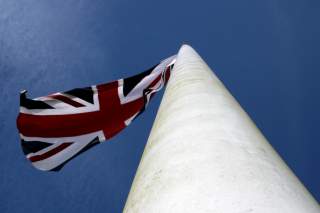Heir to the Empire
Leebaert casts Great Britain as a both a rival with a stronger position than standard accounts recognize and a partner whose global reach enabled the United States to lead from behind until the two powers broke in 1956.
Did Suez cut Britain down to size? It certainly showed the dangers of overreaching, along with underlying weaknesses that made postwar ambitions to sustain empire unsustainable. A loss of self-belief that emerged more forcefully in the 1960s fueled preoccupation with decline that still lingers. Despite undoubted strengths, Britain’s economy could not sustain the military effort it had upheld since World War I. Cuts and consolidations followed Suez to bring efforts more in line with resources, though British forces maintained a presence in the Middle East until the early 1970s and returned later on a smaller scale. Washington held the upper hand in relations, with growing U.S. assertiveness in regions where there had been little presence before. A carefully prepared speech by Richard Nixon in December 1965 marked a “declaration of independence” from British influence that the future president later called the moment where the United States took foreign policy leadership of the free world. The latter point became a theme for American newspapers and magazines from the 1950s onward.
A more significant turning point in Leebaert’s story came with the Soviet launch of Sputnik in 1957. Placing a satellite in orbit showed that the Soviets could marry nuclear weapons with rockets able to reach North America. It made the United States vulnerable to direct attack in way that it had never been before. Long-range aircraft now also had new capabilities. Besides setting the technological stakes for competition in strategic weapons at a level where only the two superpowers could compete—though Britain acquired an independent thermonuclear capability as a deterrent—the shift put America on the front line of any confrontation. Debate over a purported missile gap raised alarms during the 1960s presidential election and set an edge on the Cold War rivalry as the United States took a more forward role.
That role began under Eisenhower with interventions to shape distant regions with foreign aid, military assistance and nation building efforts that Americans hitherto avoided outside the Caribbean and Central America. Development assistance helped counter perceived Communist subversion while covert action could topple opponents and install allies. America stepped up to manage regions and their internal politics as the British increasingly stepped back. The restraint expressed by Eisenhower’s reluctance “to police the world” gave way to John F. Kennedy’s pledge to bear any burden and pay any price. An interventionist forward strategy that Walter McDougall aptly calls global meliorism became the new normal for the Cold War and beyond. National security justified an expanded defense structure guided by the “emergency men” Leebaert deplores, who lacked practical experience yet pushed aside professional diplomats and civil servants.
AMERICAN PRIMACY came from “a twisting sequence of ad hoc decisions hammered out under the stresses of sudden foreign urgencies and heavily politicized responses.” Two oceans and a continental span made the United States an island superstate rather than a superpower with global reach. A 1953 quip by the British diplomat Oliver Franks that Americans don’t do grand strategy gives Leebaert a shorthand to underline his emphasis on improvisation guided by a disinclination to lead for the decade after 1945. The liberal international system built by postwar wise men came much later in the late 1950s. “World order” expressed a much looser understanding of “constitutionalism, free trade, resistance to aggression, and, at the top, as much international cooperation as possible.” The institutional structure to uphold it built on an older, nineteenth-century legacy and came gradually in response to particular challenges until American primacy, coupled with economic recovery in Europe and Japan, gave it coherence.
Leebaert’s sprawling account puts a different spin on American and British history with an eye to current policy challenges. Besides showing the difficulties of managing empire—especially without professional diplomats and civil servants relying on practical experience rather than academic training—it makes a persuasive case for offshore balancing as a strategy. Besides incurring high costs, intervention demands skills and local knowledge while posing risks that outweigh likely rewards. Empire worked for Britain as a legacy from the nineteenth century, but it became hard to sustain, and decolonization showed that many of its benefits could be had without the burdens of direct rule.
Strengths in technology and manufacturing, along with the soft power wealth, culture and institutions provide, gave the U.S. advantages that enabled it to act where needed with local partners while stepping back when necessary. Many Americans recognized that fact and resisted a false choice between isolation and empire. Cold War pressures worked against a more pragmatic alternative, even if the language to articulate one had been at hand. Now that America and the world have emerged from a post–Cold War era of globalization characterized by muddle and improvisation, perhaps the time to draw on history and frame such a strategy for sustaining peace is at hand.
William Anthony Hay is an associate professor of history at Mississippi State University, specializing in British History, International Relations, and the Atlantic World over the eighteenth century. His latest book, published last April, is Lord Liverpool: A Political Life.
Image: Flickr / Liz Lawley

